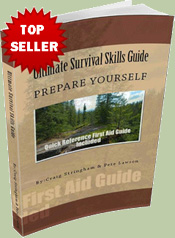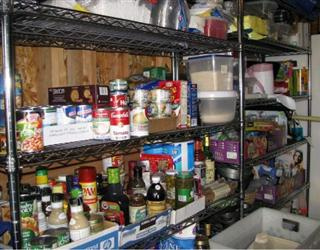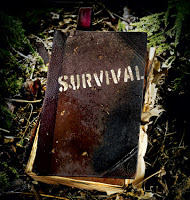Gaye Levy, Contributing Writer
Activist Post
Last month I laid out a calendar of prepping, 12 Months of Prepping, One Month at a Time. Today, I explore Month #1 in greater detail. But before getting started, I want to go back in time and have a chat about what I like to call the Survival Mindset.
The Survival Mindset is a frame of mind whereby daily life is focused on the pursuit of independence and self-reliance. This focus is done in a non-obtrusive way to the determent of no one and the betterment of everyone. It is a lifestyle and a commitment to preparedness and to courage. To optimism and to family values. Ultimately, it is the will to live and to survive with the knowledge that you have done the very best you can to protect yourself and your family from danger and the woes that come from living in complicated and uncertain times.
 |
| Ad |
What I have just described is the Backdoor Survival and SurvivalWoman mindset. And while I would like to think that it is the very best description out there, I am not arrogant enough (well, maybe just a little) to think that what works for me will work for everyone. But – and you know how I like to do this – whether you are an experienced prepper or a newbie that is just beginning to get your toes wet, you need to think about your own personal Survival Mindset and move to a survival place that meets your own needs.
Nuff’ said. I don’t want to lecture and surely, you are here to learn about Month #1. To summarize, here is what month 1 is about from the very highest level:
MONTH 1 SUPPLIES & GEAR:
- Water-3 gallons per person and per pet
- Hand-operated can opener and bottle opener
- Canned meat, stew, or pasta meals – 5 per person
- 2 flashlights with batteries
- Inventory the disaster supplies you already have on hand, including your camping gear
- If you fill your own water containers, mark them with the date they were filled
- Date cans of food and food containers if you have not already done so
Let’s talk about water first. Have you ever woken up in the middle of the night with an unquenchable thirst? That thirst is a signal that your body is dehydrated and is lacking a sufficient quantity of fluids to function. When this occurs, the blood in your body is compromised. More succinctly, it gets completely whacked out. And the result? In addition to increased thirst, dry mouth & throat and chapped lips – all of which are annoying – there is a risk of lethargy, dizziness, decreased urine output, constipation, migraine headaches, wild fluctuations in blood pressure, rapid heartbeat and ultimately, lack of consciousness. Much more, at this point, than a mere annoyance, this can, in fact, be life threatening.
So how bad really is dehydration? Back in 2001 I ended up being carted to the hospital by the local EMTs as a resulted of dehydration caused by food poisoning. Survival Husband thought he was losing me; it was not a pleasant experience.
So yes, think about water storage now and make it your number one priority.
There are are lot of ways to store water. You can purchase a 55-Gallon Barrel, you can stock up on bottled water, or, if money is tight and you are willing to do a little work, you can clean and fill some empty soda bottles with water from your tap and store them someplace cool and protected for up to six months. I have written an article on do-it-yourself water storage which you can go back to if you need some guidance with your water storage: A water freak: How to store water for emergency short term use.
The next items on the list are related: canned goods and a manual can opener. The goal here is to put away some food items that you enjoy, that require minimal cooking, are tasty and – here is the rub – are calorie dense. This is not the time to worry about the very best in low fat, diet-friendly foods. What you are looking at are foods that are going to feed your body with energy.
Have you ever analyzed the contents of M.R.E.’s? (If you are not familiar with that term, M.R.E. stands for “Meal ready to eat” such as the precooked and prepackaged meals used by military personnel in combat.) Many such meals seem tiny in quantity by today’s standards and yet the total calorie count, per meal, is 1,200 calories or more. Personally, that is my own daily calorie allotment so if ate two or three a day – oh my -I think you get the point.
The moral of this lesson is that in a crisis or emergency situation, your body needs fuel and fuel means calories. As you are planning your canned food storage items, think calories and lots of them.

One of the easiest ways for a beginner to tackle the canned food storage task is to open up their cup board or pantry and raid the contents. And for the more experienced prepper? You are still going to want to take a peek in your cupboards and take a look at the foods you are currently eating and hopefully enjoying. Have you included these with your existing supplies? What better time than now than to go take a look. Pick and choose some new items and add them to what you already have.
Here are some of the canned and prepared food items that I personally have stored away in my survival pantry:
- Canned chicken
- Canned tuna (purchase pre Fukushima)
- Canned Soups
- Canned beans
- Canned chili
- Mac and Cheese
- Peanut Butter
The last items on our Month 1 gear and supplies list are flashlights and batteries. This is one area where you are going to want to do a bit better than your 99 cent flashlight from the Dollar Store. Not that I don’t love those little LEDs that cost just a few bucks each but in a power outage, you are going to need something a bit more powerful. I like a Maglite (which could also being used to bonk someone in the head but that is another story) or a tactical flashlight. And batteries. Lots of batteries.
It is all well and good that you are a good steward of our planet and use rechargeable batteries but trust me, in a power out, grid down situation, you will be thankful that you have a healthy supply of standard Eveready’s.
Let us move on the Month 1 Tasks, the first of which is to inventory your existing supplies, including camping gear. What I did when I first got started prepping is walk around the house, the yard and the garage, taking note of the items I had on hand that
could be used if the power were out, if a natural disaster or storm shut down the roadways, or if there was some other crisis. Here is a starter list of things to check on:
- First aid supplies
- Warm blankets
- Outdoor cooking facilities
- Cooking fuel
- Knives, hatchets and saws (for cutting away brush)
- Hiking boots
- Self-powered radio gear
- Sleeping bags & tents
- Lanterns
- Firearms and self defense items
Remember, at this point we are merely taking an inventory so you can assess any gaps in your gear and think about making a purchase of those missing items in the ensuing months. The list of what you have will probably be different from the list above as will, ultimately, the list of what you need. The important thing is to know what you already have and also the condition it is in. This will insure that the money you spend down the road is well spent on items you need and not duplicates of items you already own. Also, once you have taken an inventory, you can watch for deals and sales on those very same items.
Another task for month 1 is to get out those Sharpie’s and mark the date you fill the water containers or put the food aside for emergency use. Now some will argue that you should mark everything with the expiration date but to me, you need a PhD is code breaking to understand those expiration dates that appear on cans and packaged food. I feel you are much better served by focusing on an effective rotation system – first in first out as us accountant’s like to say.
The Final Word for Month #1
The very first month in implementing your plan to be prepared does not have to be difficult, nor does it have to be time consuming or unnecessarily expensive. Please, whatever you do, do not get frustrated. There is a lot of support out there in the online community to help you get going.
And for the not-so-newbie? What better time than now to go back and review your progress and perhaps share your experience with an unenlightened family member or a favorite friend. Send them a copy of this article and help them formulate their own Survival Mindset. Be gentle with them if they don’t at first understand. In the long run, they will thank you.
Gaye Levy, the SurvivalWoman, grew up and attended school in the Greater Seattle area. After spending many years as an executive in the software industry, she started a specialized accounting practice offering contract CFO work to emerging high tech and service industries. She has now abandoned city life and moved to a serenely beautiful rural area on an island in NW Washington State. She lives and teaches the principles of a sustainable, self-reliant and stylish lifestyle through emergency preparation and disaster planning through her website at BackdoorSurvival.com. SurvivalWoman speaks her mind and delivers her message with optimism and grace, regardless of mayhem swirling around us. Enjoy your next adventure through common sense and thoughtful preparation!
linkwithin_text=’Related Articles:’



Be the first to comment on "Getting Prepared Month 1: Supplies, Gear and Tasks to Get You Started"